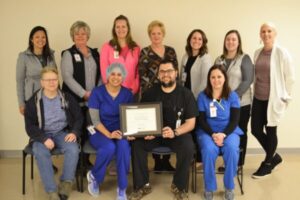
May is National Stroke Awareness Month and arguably warrants the public’s attention as the nation’s fifth leading cause of death and the leading cause of serious long-term disability. Every year, more than 795,000 people in the United States have a stroke. About 610,000 of these cases are first or new strokes.
“Knowing the signs of a stroke and being able to react FAST is the first step to helping your friends and family when the clock is ticking,” said Dr. Harman Dhaliwal, Sleepy Eye Medical Center.
Stroke occurs when something blocks blood supply to part of the brain (ischemic stroke) or when a blood vessel in the brain bursts (hemorrhagic stroke). A stroke causes brain tissue to die, which can lead to brain damage, disability and death.
Anyone, including children, can have a stroke at any time. Some uncontrollable risk factors include age, family history, sex and ethnicity. The likelihood of having a stroke increases with age for both males and females. In addition, if a parent, grandparent, sister or brother has had a stroke—especially before age 65—one may be at greater risk. Women and African-Americans also tend to be at higher risk.
However, developing a healthy lifestyle can help reduce risk of stroke. Steps you can take include:
- Eat a healthy diet low in sodium with plenty of fruits and vegetables.
- Maintain a healthy weight.
- Be physically active.
- Don’t smoke, and avoid secondhand smoke.
- Limit alcohol consumption.
- Prevent or manage other health conditions, especially high blood pressure, high cholesterol, diabetes and obesity.
Stroke can also be treatable, and by learning the signs and getting fast treatment, you can prevent death and disability from stroke. An easy way to recognize the signs and symptoms of a stroke is the acronym B.E. F.A.S.T.:
- B = Balance loss
- E = Eyesight changes
- F = Facial droop/numbness
- A = Arm weakness
- S = Speech difficulty
- T = Time to call 911
If a person shows any of these signs, it’s important to call 911 immediately. When transported by ambulance, first responders may be able to begin treatment right away and can alert the hospital that a stroke patient is in route.
As a designated Acute Stroke Ready hospital, Sleepy Eye Medical Center is prepared to evaluate, stabilize and provide emergency treatment to patients with acute stroke symptoms. Through the Telestroke program, SEMC’s emergency department can access expert advice of stroke specialists, 24 hours a day, by using video technology. This partnership promotes quick, accurate diagnosis of stroke so that proper treatment can begin as soon as possible.
“When stroke symptoms occur, time is of the essence in seeking medical attention in order to prevent long-term complications or even death. Often, people wait to see if the symptoms will go away or call their friends, family or physicians to verify the symptoms. If you are experiencing or see someone experience them, the best course of action is to immediately call 911,” said Dr. Dhaliwal.
As soon as SEMC is notified of a possible stroke, the emergency team prepares for the patient’s arrival. SEMC’s team will work together to:
- Connect with a stroke neurologist at Abbott Northwestern Hospital’s certified comprehensive stroke center using Telestroke video technology equipment
- Perform necessary tests
- Complete a head CT scan
- Work with a stroke neurologist to evaluate stroke symptoms
- Administer clot busting medications, if necessary
- Arrange for air transportation to a stroke center if advanced care is needed
Stroke neurologists at stroke centers now have the capability to manually remove larger clots through a surgical procedure called a thrombectomy up to 24 hours after the last time someone was known to be well or without symptoms.
To learn more about SEMC’s emergency services or Telestroke Program, click here. Additional resources and information about stroke can be found on the American Stroke Association website.